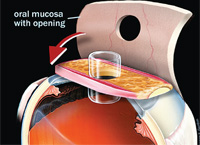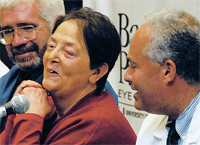In the procedure, headed up by Victor Perez, M.D., associate professor of ophthalmology at Bascom Palmer Eye Institute, Ms. Thornton’s eyetooth and surrounding bone was extracted, shaved and sculpted. An optical cylinder lens was inserted through a hole in the tooth. Then the tooth and lens were implanted under the patient’s skin to help them bond as a bio-integrated unit. During this time, the surgeon prepared the eye by removing any scar tissue surrounding the cornea. In about one month, mucous material from the inside of Ms. Thornton’s cheek was used to rehabilitate the ocular surface, and two months later, the prosthesis was removed from under her skin and finally implanted in her eye.
 |
 |
| A shard of the patient’s tooth and surrounding bone were combined with a cylinder lens to create an ocular prosthesis. | Within two weeks, Sharron Thornton had 20/70 vision and could read the newspaper. At right is her surgeon, Victor Perez, M.D. |
Two weeks post-op, Ms. Thornton’s was reading newsprint with a visual acuity of 20/70. Her vision is expected to improve further as her surgical scars heal. Six years ago, Ms. Thornton had undergone an unsuccessful stem cell procedure. She was not a candidate for corneal transplant.
“For certain patients whose bodies reject a transplanted or artificial cornea, this procedure ‘of last resort’ implants the patient’s tooth in the eye to anchor a prosthetic lens and restore vision,” says Dr. Perez.
“I’m looking forward to seeing my seven youngest grandchildren for the first time,” says Ms. Thornton. “Without sight, life is really hard. I’m hoping this surgery will help countless people.”

